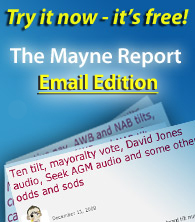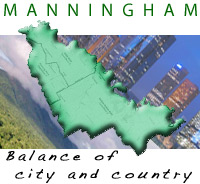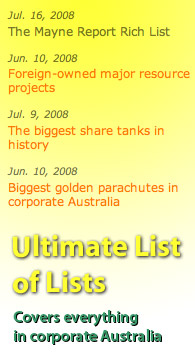Snowy float, privatisation debate, sporting MP's, UniTab, Rio
July 22, 2008
Here are Stephen Mayne's eight stories from the Crikey edition on Friday, 2 June, 2006.
1. Snowy float pulled – implications everywhere
By Stephen Mayne
John Howard pulled the rug out from under the Snowy Hydro float this morning and NSW Premier Morris Iemma followed suit within the hour, so the Victorian and NSW Governments are now in a major budget bind as both were expecting to launch pre-election spending sprees with the proceeds from their combined 87% stake.
However, there is an option that could still generate cash. Snowy Hydro was being valued at $3 billion yet the business is only carrying $600 million in debt. The company is probably the last NSW government controlled business that hasn't been loaded to the gills with excessive debt to prop up an unsustainable budget spending spree over the past ten years.
Therefore, backed by all the forecasts worked up in the prospectus, Snowy Hydro could easily raise another $1 billion in debt for a special return to shareholders, although this would also reinforce the financial desperation of Morris Iemma, whose budget next Tuesday is now looking even more wobbly.
Democrats senator Lynn Allison claims that $18 million has already been spent on the botched privatisation plan and the Federal Budget revealed that an estimated $110 million would be spent in total. It is John Howard who should carry the can for this because he alone pulled the float by breaking from the bipartisan support it had at a state and federal level. Similarly, John Howard was responsible for the cancelling of the proposed Liberal-National merger in Queensland when a competent PM would have ensured it never saw the light of day in the first place. The man of steel is nothing but a rank opportunist and this latest backflip will seriously undermine his credibility for upcoming privatisations such as Telstra and Medibank. A more sensible compromise would have been to park 10% of Snowy Hydro in the Future Fund, although cranky David Murray probably would have arked about that.
The man of steel is nothing but a rank opportunist and this latest backflip will seriously undermine his credibility for upcoming privatisations such as Telstra and Medibank. A more sensible compromise would have been to park 10% of Snowy Hydro in the Future Fund, although cranky David Murray probably would have arked about that.
Similarly, a more sensible compromise for Morris Iemma would have been to do a deal with Steve Bracks so that only 49% of Snowy Hydro was floated. That would have also given the market time to understand the complex derivatives aspect of the business before the balance was privatised.
It will be fascinating to see how much the bevy of investment bankers – UBS, CS First Boston, JP Morgan, Macquarie Bank and Goldman Sachs -JB Were – will collect for this breach of contract. And will the newly installed directors such as chairman Rick Holliday-Smith stick around? If not, will they be compensated? How much of a pay rise was proposed for Labor figure Bob Hogg, one of the longer term Snowy directors who was sticking around for the float?
There are just so many angles to this story, including that we haven't seen a populist people power uprising like this for quite some time. The implications are many and varied but the biggest winner is undoubtedly NSW opposition leader Peter Debnam, because the saga has confirmed to the public what a mess Labor has made of NSW public finances.
2. So who's responsible for the Snowy "victory"?
By Stephen Mayne
They say victory has a thousand parents and defeat is an orphan.
And so it will be with the great Snowy Hydro privatisation backflip as a cacophany of politicians, ginger groups, media types, activists, celebrities and engineers put up their hand to claim credit for John Howard's astonishing backflip after ten years of relentless campaigning for across-the-board privatisation.
The NSW Greens and Bob Brown are already claiming credit, but a bitterly disappointed John Brumby told ABC Victoria this morning that Sydney shock jock Alan Jones had played a major role – "Alan Jones says it's a bad idea so the Prime Minister thinks it's a bad idea," he told ABC Radio. The Parrot got aboard the anti-privatisation wagon over the past month and helped whip up a frenzy, albeit not a drunken mob like in Cronulla, so his reputation for political king-making will only be further entrenched by this episode.
John Howard declared that he was surprised by the groundswell of opposition which was certainly kicked along yesterday by the open letter from 56 prominent Australian including Malcolm Fraser and Cate Blanchett, who will certainly be invited to any "victory" party that is held in Cooma.
Various independent politicians are also being mentioned in dispatches. For instance, the Federal triumvirate of Bob Katter, Tony Windsor and Peter Andren met with the PM for over an hour on Wednesday and were always trying to roll the whole deal, rather than just limit foreign investment.
Then there is the original Snowy independent, Victoria's Craig Ingram, who was receiving much popular support for his High Court challenge and will probably retain his seat of Gippsland East at this year's state election without even going to preferences after all the publicity his anti-privatisation campaign has received. Indeed, Ingram will probably be able to successfully back an independent into the fifth spot in the newly created upper house region of Eastern Victoria, a bit like the way Nick Xenophon's running mate got elected in South Australia earlier this year.
As a close confidant of the PM, NSW Senator Bill Heffernan will also rank right up there given his strident commentary and this is where the motivations of the players get interesting. Now that the NSW Right – led by Heffernan and Howard – have absolute control of the NSW Liberal Party they would be acutely aware of the political boost the whole saga has given Peter Debnam. There are now serious questions over Morris Iemma's future as he looks more and more like Barrie Unsworth as each day passes and most NSW voters believe that Labor has stuffed the state's finances.
The challenge now for the Heffernan-Howard Right is to preselect quality candidates to generate the 10% swing needed to unseat Labor. Pru Goward is the first of many being promised by an energised and triumphant group. However, NSW voters remain underwhelmed by the depleted opposition so it could yet be a motley crew of independents, led by the likes of Wendy Harmer, who end up being the biggest political beneficiaries of this extraordinary saga.
The Liberal Member for Eden-Monaro, Gary Nairn, is perhaps the most relieved politician today because he would almost certainly have lost his seat to a Snowy-linked independent at next year's federal election.
3. Stand by for the mother of all privatisation debates
By Stephen Mayne
The abandoned Snowy Hydro float will probably generate the biggest privatisation debate we've seen in Australia and talkback this morning has been full of joyful citizens railing against the sale of any publicly owned assets.
Therefore, it's important to lay down a few debate guidelines in assessing what should be privatised in future and what has been successful in the past. There's no doubt that water is the most politically sensitive asset to sell, with only the South Australians trying what turned out to be a disastrous outsourcing arrangement in the mid-1990s. Snowy will ensure the rest of the water industry remains in government hands for the foreseeable future.
ABC Melbourne's Jon Faine this morning claimed that the privatisation of Tabcorp was a great success yet the sale of Victoria's public transport assets was a disaster. In my view, the exact opposite is true. The Tabcorp sale was a disaster because Victoria got nothing like the full value for the two gambling licences and the privatised company has brutally targeted Victoria's poorest suburbs with their insidious machines.
Sure, National Express withdrew from one of the public transport franchises in 2002, but the whole privatisation arrangement ended up saving taxpayers at least $500 million because the private companies all failed to turn a buck despite driving efficiency gains and keeping the trams and trains running.
IPA executive director John Roskam was trying to argue this morning that all privatisations have been good because they lead to lower prices and he cited gas and electricity privatisation in Victoria. This is absolutely true because the $30 billion Victorian energy sell-off represented more than full value, totally transformed the state's balance sheet and delivered lower prices to consumers.
However, the same can't be said for bank privatisation because since the Commonwealth Bank and the various state banks were privatised, an enormously powerful private cartel has emerged and Australians now pay more for banking services than virtually any other citizens in the world. The same applies with Sydney Airport when the Feds happily pocketed $5.6 billion but have since tolerated gouging that has lifted its value to more than $7 billion.
However, bank privatisation could well have worked if the Reserve Bank, ACCC and Peter Costello hadn't allowed the cartel to gouge away with its ears pinned back for the last decade, so much so that the privatised banking assets are now worth about $75 billion yet taxpayers only collected about $15 billion. Indeed, there were tremendous efficiency gains after bank privatisation but none were passed on to consumers so you have to declare it a failure.
Finally, it is important to recognise that some assets perform well in government hands. Victoria's Transport Accident Commission should be running a national monopoly in third party insurance given its amazing success over the past 17 years and Australia Post has also done tremendously well under managing director Graeme John for the past decade.
5. John Della Bosca's torrent of Snowy garbage
By Stephen Mayne
NSW finance minister John Della Bosca has just spewed out the greatest load of garbage about the Snowy privatisation backflip as he repeatedly claimed on The World Today that the float couldn't proceed without the Commonwealth.
This is complete rubbish because the NSW Government initially announced its sale of the 58% stake without any reference to Victoria's 29% stake or the Federal Government's marginal 13% stake.
Of course the float could have proceeded with the Feds retaining 13%. It was pulled because of the political realities, something Della repeatedly denied.
Della Bosca also claimed that Snowy Hydro desperately needs capital – between $300 million and $1 billion over the next five years – and was now condemned to a slow death without the float.
Bollocks. Snowy Hydro was being valued at $3 billion and only carries $600 million in debt. It has plenty of balance sheet capacity to borrow for any capital expansion program and the three government shareholders could simply forgo dividends for a while if it really is hard up for capital.
The business generated revenue of $440 million in 2004-05, the last available accounts, and produced a pre-tax profit of $199 million, down from $215 million in 2003-04. A $100 million dividend was paid out, which is hardly the action of a $3 billion company servicing only $600 million in debt and supposedly hard up for capital.
However, Della was right about one thing. If John Howard is so keen for the Snowy to remain in public hands, the Feds should buy the 58% NSW stake. Given that the Future Fund is about to have $30 billion in cash looking for a home, this isn't as stupid as it sounds, although the credibility of any Telstra or Medibank Private sell-off would be undermined ever further by such a move.
15. Getting close to a comprehensive sporting MPs list
By Stephen Mayne
We're starting to get closer to a comprehensive list of sporting tilts at politics. The latest nine new names are below and everyone else we've mentioned so far is listed here on the website. If you can come up with any additional names, please email smayne@crikey.com.au.
Roy "Bud" Abbott: the former South Adelaide footballer was ALP member for Spence from 1975 to 1989 and also held several ministerial portfolios in the Bannon Government.
Chris Natt: played 300 games for Port Adelaide before it joined the AFL and is current Labor member for Drysdale in the Northern Territory Parliament.
Cory Bernardi: the newest South Australian Liberal senator rowed for Australia and also enjoyed Liberal largesse as chairman of the Australian Sports Foundation and a director of the Australian Sports Commission and the Australian Institute of Sport.
Wilfred Kent-Hughes: represented Australia in the 400m hurdles at the 1920 Antwerp Olympics and then went to hold the seat of Kew in the Victorian Parliament from 1927-1949, originally as a Progressive Nationalist before he and Robert Menzies founded the Young Nationalist Organisation in 1930. Held various portfolios in the United Australia Party-Country Party ministry of 1932-35.
Ron McAuliffe: played rugby league for Queensland and is best remembered as the QRL President who came up with the current state of origin concept in 1980. Not so well remembered for his contributions as a Labor senator.
Ian McLachlan: South Australian shield cricketer who rose to be John Howard's first Defence Minister.
Kym Richardson: the former Glenelg footballer is currently the Liberal member for the federal seat of Kingston.
Nick Shehadie: in an international career from 1947 to 1958, was the cornerstone of Australia's rugby union team as a prop and second rower who went on be Lord Mayor of Sydney 1973-4, and deputy 1979-87.
Athol Townley: Sheffield Shield cricketer for Tasmania who was Liberal Member for Denison 1949-1963. Served as Minister of Air and Civil Aviation 1954-1956, Minister for Immigration 1956-1958 and Minister for Defence 1958-1963.
Mick Veivers: The National Party MP for Southport and former Minister in the Borbidge Government got his profile from playing rugby league for Queensland and Australia more than 30 years ago.
23. Why Unitab shareholders should ditch Tattersall's
By Stephen Mayne
Never before in Australia has a big takeover deal carried as much political risk as Unitab's proposed merger of equals with Tattersall's. In fact, Unitab shareholders would be well advised to take the relative security of Tabcorp scrip rather than the far more precarious Tattersall's alternative which relies on heroic assumptions about what will happen to its outrageously lucrative poker machine licence in Victoria after it expires in 2012.
As someone who is looking seriously at running in the Victorian state election on this vehemently anti-pokies platform, I can tell you that the ducks are all lining up to maximise pressure on the Bracks government for a substantial reduction in machine numbers. For instance, the following appeared in The Age yesterday:
Labor's decision to ignore new technology aimed at problem gambling in this week's budget has exposed the Government's reliance on gaming revenues, according to the former chairwoman of the state's independent gaming research panel. Linda Hancock, who will advise the fledgling People Power party on gaming issues at this year's state election, said exceeding $1 billion in revenue from poker machines was "a big concern".The Liberal Party was already promising a cut in non-Crown machine numbers from 27,500 to 22,500 before new leader Ted Baillieu came along and declared all policy was up for review and a further reduction in poker machine numbers was a high priority. When Baillieu took calls on ABC radio yesterday, he was immediately confronted by reformed pokies addict Gabi Byrne, who is People Power's candidate in eastern Victoria.
But it goes much wider than that. Putative Greens leader Greg Barber, who fancies himself to be leading a balance of power team in the reconstituted upper house after 25 November, was given a minute to respond to the state budget on Jon Faine's 774 ABC Morning program on Wednesday and chose to go with excessive reliance on poker machines as his key gripe. Family First is also dead against the pokies and there are elements of the Labor left that are toying with public campaigning on the issue come election time.
Combine all that with the extraordinary 21.5% state-wide vote that South Australian No Pokies independent Nick Xenophon got in this year's election and the prospect that he will enter the Victorian contest, and you have quite a political movement against Tattersall's, not to mention a Labor Party which remains embarrassed about gifting the $2 billion licence for free back in 1991. With Labor budgeting to borrow $1.5 billion in 2007-08, the pressure will also be on to maximise any new licence fee both Tabcorp and Tattersall's will pay.
Gaming analysts, Unitab shareholders and the independent experts from Deloitte really should consider all of this before making big statements about the future prospects of Tattersall's because some close observers of the Victorian political scene reckon they are a screaming sell. Tabcorp is also exposed, but at least they are far more diversified.
24. Why couldn't the states have enjoyed this wagering bonanza?
By Stephen Mayne, small shareholder in Tabcorp and Tattersalls
Tabcorp's $2.1 billion takeover bid for Unitab finally brings the spectre of one national tote for the racing industry into play. However, it's a real shame for the taxpayers of Victoria, NSW and Queensland that their governments couldn't have got together and done the deal themselves before flogging off the lucrative wagering licences at knock-down prices.
How must the Beattie Government feel about floating Unitab at just $2 a share in November 1999 when Tabcorp is now offering $14.25 seven years later? Then again, how stupid do Jeff Kennett and Alan Stockdale feel about floating Tabcorp at just $2.25 a share in August 1994, when the stock closed at $15.95 yesterday and has paid out about $5 a share in dividends since listing?
Similarly, the Carr government only fetched $2.35 a share when the NSW TAB was floated in 1998 only to see Tabcorp come along six years later and pay about $5 a share, depending on how you value the scrip that was handed over.
Sure, a portion of that value, especially in the case of Tabcorp, has come from poker machines rather than wagering, but imagine if our three biggest state governments had created a state-owned national pool, bedded down all the synergies and then floated the lot for more than $3 billion rather than the $1.5 billion or so that they got for the three state wagering monopolies.
Sadly, petty inter-state rivalries all too often get in the way of rational decision making. For instance, why on earth haven't other states invited Victoria's hugely successful Transport Accident Commission to come in and run their more expensive and less comprehensive compulsory third party insurance schemes?
Even since we got wall to wall Labor governments in the states and territories there has only been limited reform such as uniform defamation laws, although that only occurred after the Federal Government threatened to come over the top with new national defamation laws.
Australia's workers' compensation laws remain a dog's breakfast of eight different systems, although at least the Feds are now trying to make its Comcare system available to private companies. You can only shake your head in disbelief at the way Australia's cumbersome federation and excessive three levels of government has held the nation back over the years.
25. Rio Tinto's 100% owned iron-ore mines
By Stephen Mayne
The AFR had an interesting story about BP Australia's record profit yesterday, in which it revealed that $1 billion in after-tax dividends had been shipped back to the London head office in 2005.
Given the extraordinary profits being recorded during this heady resources boom, it would be fascinating to track how the cash actually flows and whether much of the windfall gains are being being reinvested in Australia. For instance, does Swiss-based Xstrata actually get its Japanese coal customers to send the money to an Australian bank account, or does it just go straight to Europe and then royalty and company tax payments get sent back to Australia later?
It's all food for thought given the xenophobia displayed over the aborted Snowy Hydro float. Here are another four $1 billion-plus resources projects for our who owns Australia list and they're all 100% Rio Tinto iron-ore operations in the Pilbara, which makes them just 15% Australian owned given that foreign shareholders dominate the register of the London-based dual-listed company.
Brockman/Nammuldi: Located about 60 km north-west of Tom Price in the Pilbara and 100% Rio Tinto owned, so Australian ownership only 15%. First opened in 1992 and then re-opened after a major upgrade in 2003. Annual production of 8 million tonnes worth $560 million based on 2006 contract prices so WA royalty will be $21 million based on 3.75% rate.
Marandoo: Commissioned in 1994, this 100% Rio Tinto operation is located about 45km from Tom Price and adjacent to the Karijini National Park. The nominal production capacity of 15 million tonnes is worth about $1.05 billion based on 2006 prices. Australian ownership is only 15% but the WA government collects a 3.75% royalty worth about $38 million this year.
Mt Tom Price: Rio Tinto's oldest operation started production in 1966 and still produces up to 20 million tonnes a year worth up to $1.4 billion based on 2006 contract prices, although this is in decline. Australian ownership only 15% through Rio but WA government royalty of 3.75% will produce about $50 million this year.
Paraburdoo: 100% owned by Rio Tinto which is 15% Australian owned. Produced 11 million tonnes in 2005 which is worth $770 million based on 2006 prices so the WA royalty would be $29 million based on 3.75%.
Feedback, corrections and additions to smayne@crikey.com.au
Copyright © 2024 The Mayne Report. All rights reserved






















